[Editor's note: This story, originally posted on March 5, has been updated to include more information about the scope of the exercises and about the allies' military strategy operation plan, OPlan 5015, which reportedly includes the possibility of pre-emptive strikes.]
More than 15,000 U.S. and 300,000 South Korean troops have kicked off simultaneous joint military drills on the Korean Peninsula aimed at countering North Korean aggression.
The joint military drills — Key Resolve and Foal Eagle, the largest in scale since 2010, will continue through early April. The previously scheduled exercises come amid new UN Security Council sanctions against the "Hermit Kingdom" following North Korea's nuclear and long-range missile tests in January and February. South Korea has announced its intention to apply stiff new sanctions of its own this week.
North Korean leader Kim Jong Un has ordered his country's nuclear weapons to be at the ready, and threatened to launch nuclear strikes on both South Korea and the U.S.
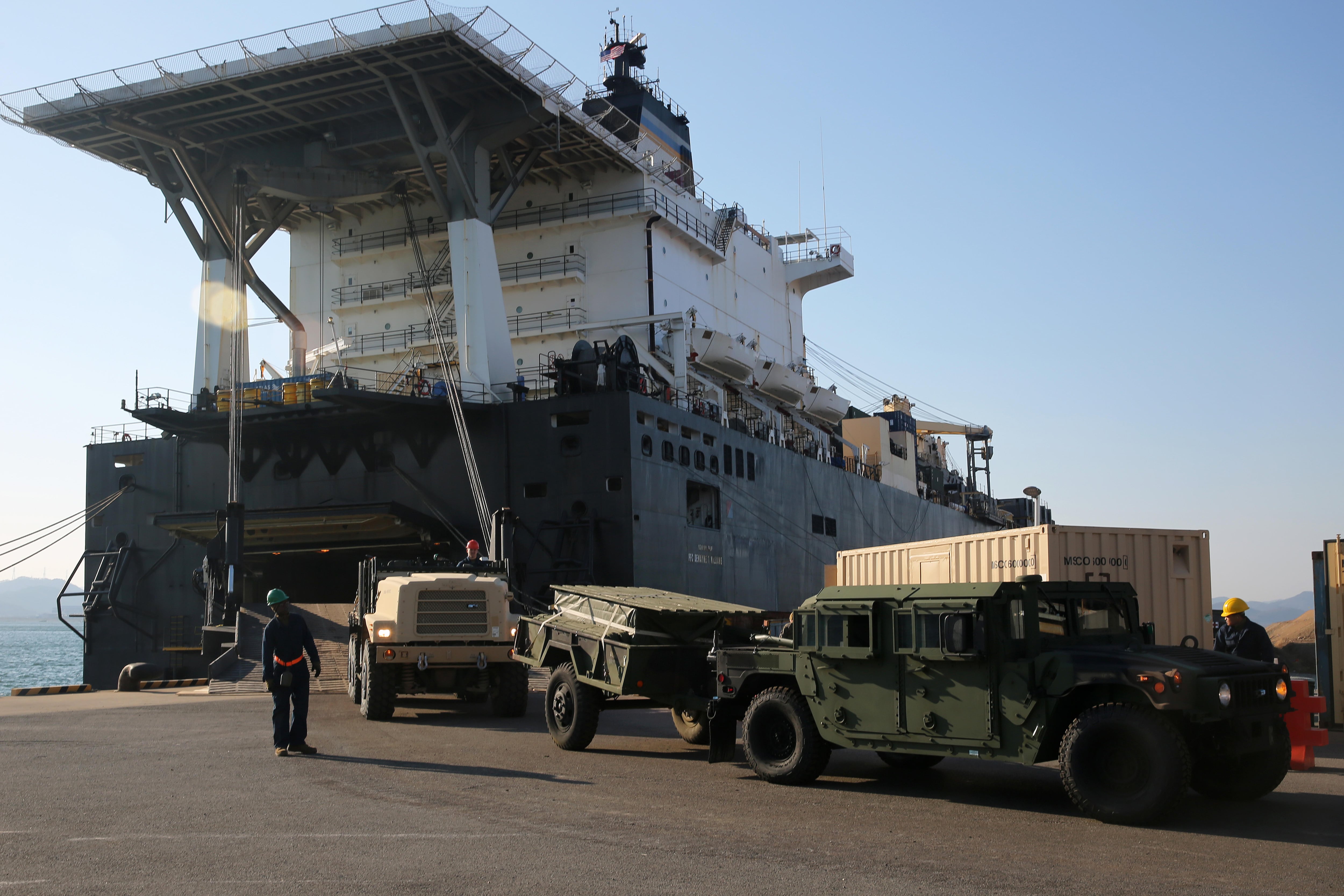
Marine Corps vehicles emrge from Military Sealift Command's prepositioning ship USNS PFC Dewayne T. Williams March 1. The Williams was carrying Marine Corps equipment to be used for Exercise Ssang Yong 2016. The Williams was one of three MPF ships that offloaded her cargo in support of SY16.
Photo Credit: Grady T. Fontana/Navy
South Korean newspapers are reporting that, for the first time, Key Resolve will test the new U.S.-South Korean military strategy operation plan, Operations Plan 5015, which aims to deter North Korea's possible use of weapons of mass destruction by preemptive attack. The Korea Times reports that OPlan 5015 "calls for promptly hitting back after North Korean attacks through a preemptive strike on the North's core military facilities and weapons as well as its top leaders," to include Kim.
The drills include several other exercises.
About 2,100 Marines and sailors with the 31st Marine Expeditionary Unit out of Okinawa, Japan, along with the amphibious assault ship Bonhomme Richard and the amphibious dock landing ships Ashland and Germantown, recently arrived in South Korea for exercise Ssang Yong 16, which began March 2 and continues through March 20, Marine Corps officials said. All told, about 3,000 troops from the Republic of Korea Marine Corps and 7,000 U.S. troops are taking part. Five Military Sealift Command prepositioning ships have joined the drill.
Held every two years, the Ssang Yong exercise involves U.S. and South Korean troops conducting amphibious operations for possible disaster relief or wartime missions, said 2nd Lt. Joshua Hays, a Marine Corps spokesman.
In addition, Key Resolve involves the participation of the aircraft carrier John C. Stennis and its strike group, the submarine North Carolina, F-22 Raptors and nuclear-capable B-2 bombers, according to Korea Times.
Meanwhile, North Korea has recently tested a nuclear weapon and fired six projectiles into the sea, just as it did in 2013, said Bruce Klingner, a Korea expert at the Heritage Foundation think tank in Washington, D.C.
"Things could get dicey in the next couple months," said Bruce Klingner, a Korea expert at the Heritage Foundation think tank in Washington, D.C. "We’re already seeing North Korea starting to issue threats: If the U.S. doesn’t stop these exercises or doesn’t cancel these exercises, North Korea may take appropriate action. They also highlight that there are a number of strategic assets that will be part of it: nuclear-capable submarines, B-52s, F-22s, etc., special forces Marines — all of which, in the North Korean eyes, or the North Korean depiction, is a prelude to an attack on North Korea."
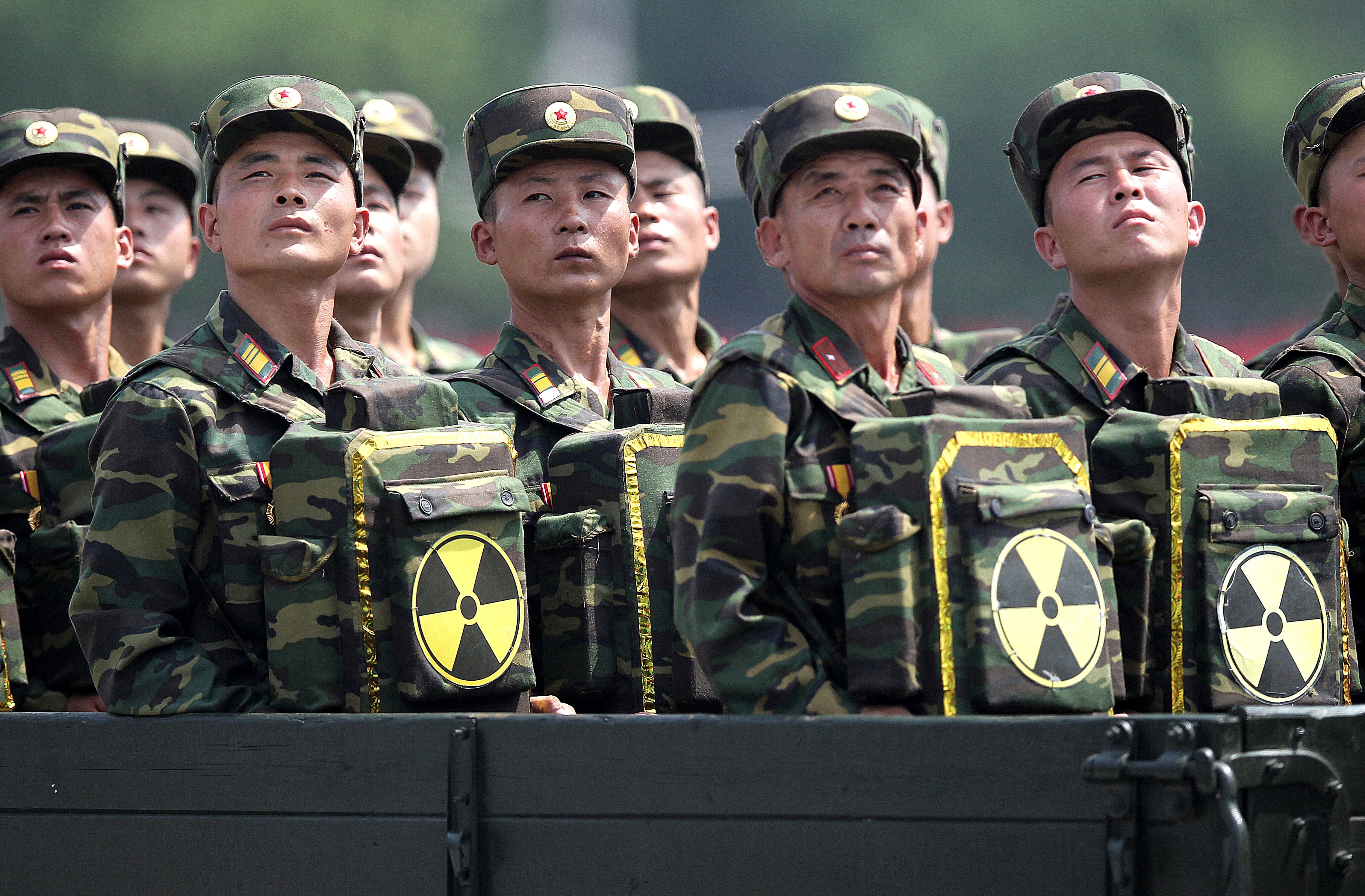
North Korean soldiers look toward their leader, Kim Jong Un, during a July 2013 parade to celebrate the 60th anniversary of the Korean War armistice in Pyongyang, North Korea. Their packs are marked with the nuclear symbol.
Photo Credit: Wong Maye-E/AP
It is unclear whether North Korea actually believes that the exercise is camouflage for an invasion by the U.S. and South Korea or it is trying to frighten South Korea into canceling the exercise, but with the militaries from both sides operating so closely to each other, the chances of something going wrong increases, Klingner said.
"In their statements, they certainly declare that they see the potential for a U.S. attack," he said. "They will point to U.S. attacks on Libya and Iraq and Serbia as indicative of what the U.S. and its allies might do to them."
The North Koreans are particularly wary at seeing Marines on the Korean peninsula, Klingner said. In September 1950, Marines and soldiers launched an amphibious landing at Inchon that stopped the North Korean advance south and led to UN forces crossing the 38th parallel into North Korea.
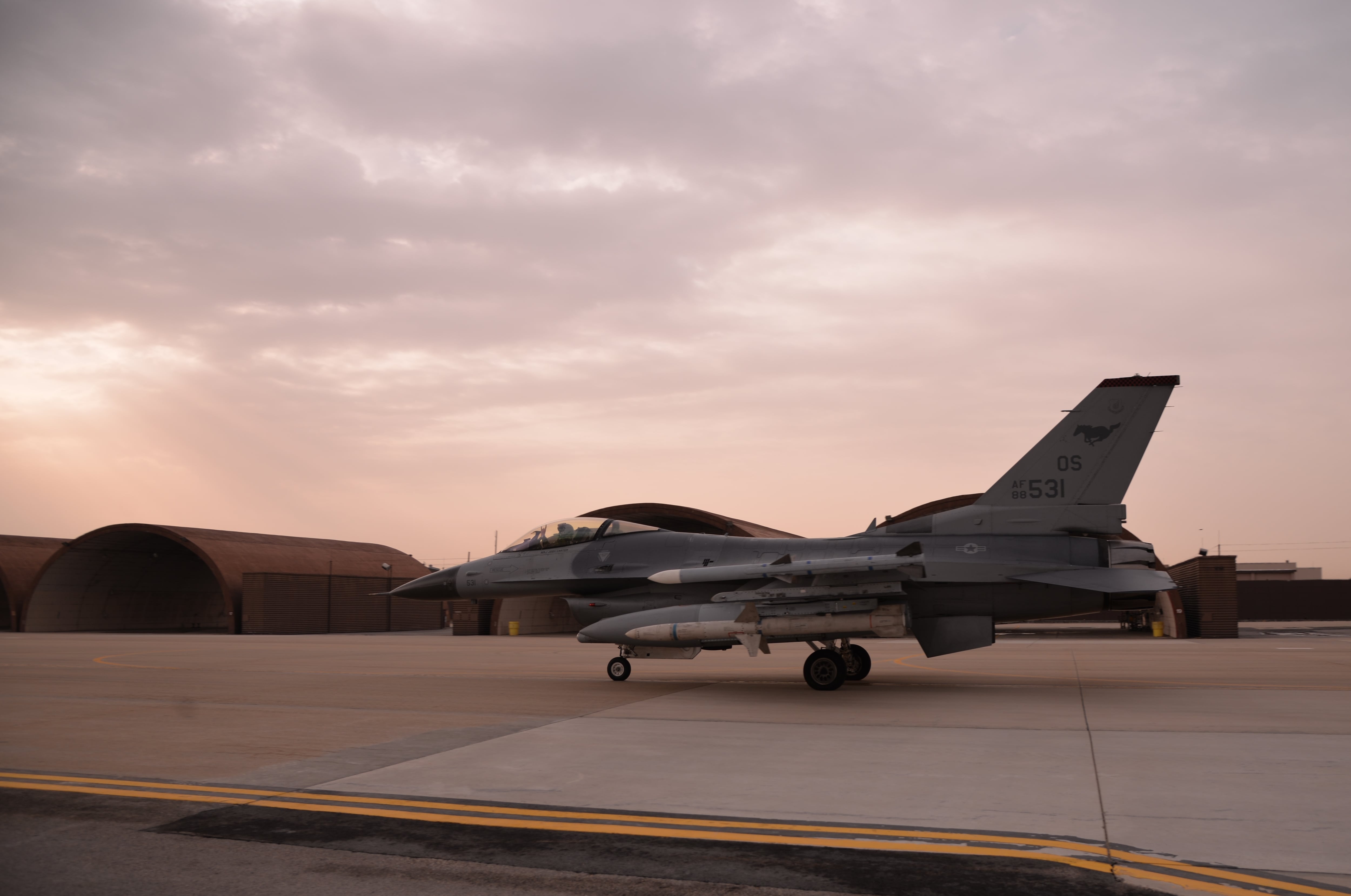
An F-16 Fighting Falcon assigned to the 36th Fighter Squadron taxis before taking off March 7 at Osan Air Base, Republic of Korea. Members of the 36th Aircraft Maintenance Unit generated multiple aircraft throughout the day in preparation for combat readiness exercise Beverly Midnight 16-01.
Photo Credit: Staff Sgt. Benjamin Sutton/Air Force
"Gen. B.B. Bell, the former commander in chief of U.S. Forces Korea, he said that the Marines on Okinawa were his maneuver unit," Klingner said. "They were the ones that would carry out operations behind the front lines, behind the DMZ [demilitarized zone].
"The North Koreans know that. They know the history of the Marine Corps, so they would see a large presence of Marines on the peninsula as possibly a prelude to an attack or an invasion — especially when it's coupled with the presence of B-52s and nuke-capable submarines."
However, The current exercise, however, was scheduled long before the most recent tensions on the Korean peninsula, said retired Army Special Forces Col. David Maxwell, associate director at the Center for Security Studies at Georgetown University. For decades, the U.S. has held combined military exercises with South Korea during this time of year to send a message to North Korea.
The North Korean military is about to finish its winter training cycle, when it will be at its highest state of readiness, Maxwell said in an interview.
"That's important because this month and next month are the optimal times for the invasion of the South, where the ground is still hard and the rice paddies have not been flooded," he said. "That makes the best time for maneuver on the peninsula."
By bringing U.S. and South Korean forces to a high state of readiness, the alliance is letting North Korea know that it would be unwise to attack, Maxwell said.
"I believe the North Korean leadership, the military leaders in particular, are smart enough to know that you don't attack into strength," Maxwell said.
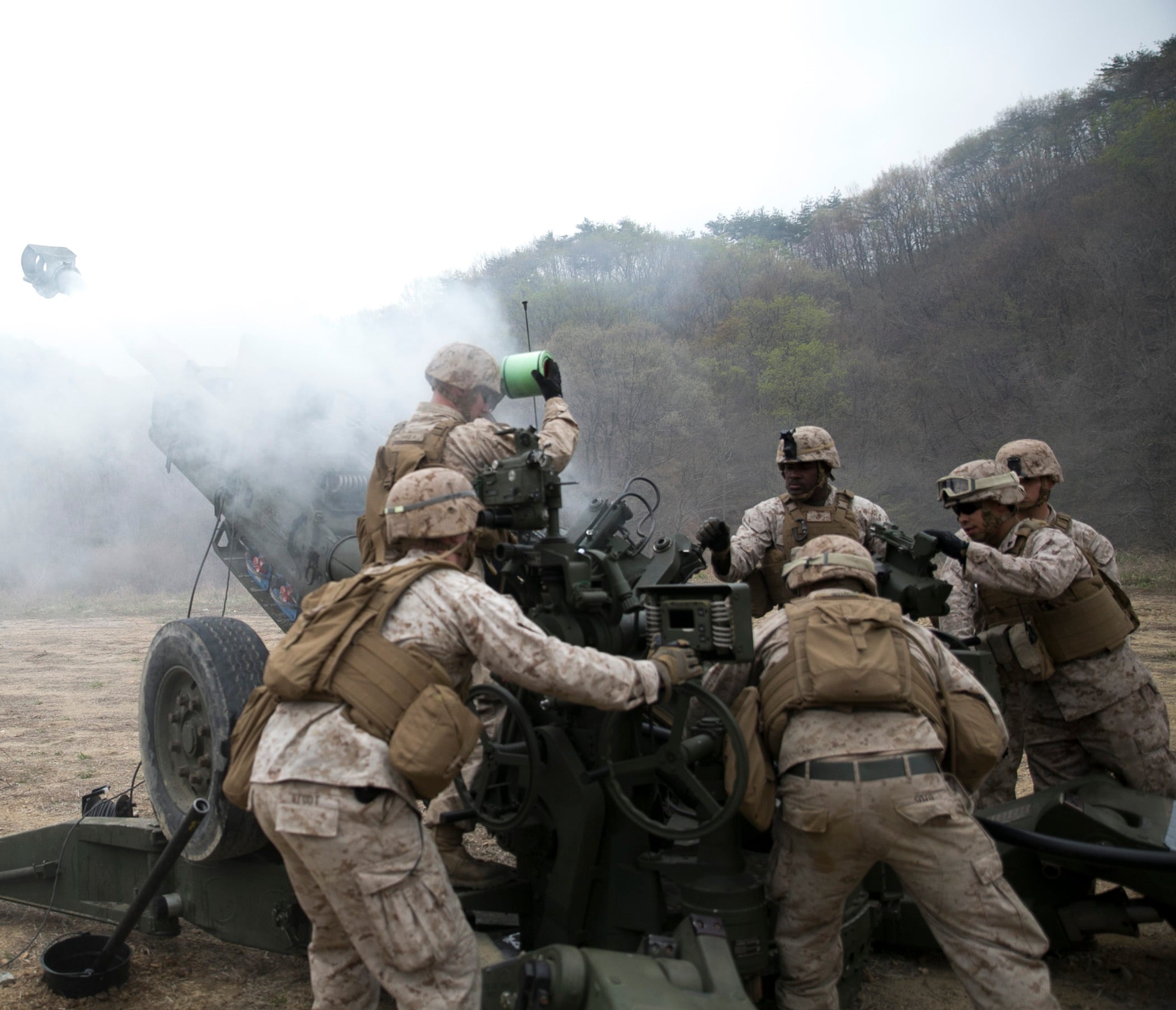
Artillery Marines fire off rounds from M777A2 lightweight 155 mm howitzers at Su Seung-ri Range in the Republic of Korea as part of Exercise Ssang Yong 2014.
Photo Credit: Cpl. Lena Wakayama/Marine Corps
While Marines have conducted past amphibious exercises in South Korea, they need to keep those skills fresh in case the U.S. Forces Korea commander needs to call upon Marines to land on either of North Korea's coasts, he said.
"It's a critical capability that will give the commander many different options in actual war," Maxwell said. "It is also important as well from a humanitarian assistance. If the regime collapses; if we have the mother of all humanitarian operations that needs to take place in the North … the ROK [South Korean] and the U.S. Marines will have a capability to get humanitarian assistance to either the east coast or west coast."
While the U.S. believes these military exercises work to deter North Korean aggression, "we don't know what goes on in the mind of Kim Jong Un," Maxwell said.
His father Kim Jong Il had 21 years during which he was the designated successor in which to kill any possible rivals, Maxwell said. The younger Kim only had two years to prepare to take his father's place. Since then, he has eliminated several senior North Korean leaders, and that could indicate that he is still consolidating his power.
"Given his leadership style and his inexperience and the fact that he has had so many violent purges of senior leaders, I do worry that military leadership may not be able to tell the emperor he wears no clothes," Maxwell said. "They may only be telling him things they think he wants to hear."
If North Korean military leaders are not giving Kim accurate information about U.S. and South Korean military strength, Kim may decide to invade, especially during times of instability or if Kim feels he is facing internal opposition, Maxwell said.
"His rational option may be to execute his campaign plan to try to unify the peninsula to try to ensure his survival," Maxwell said. "To us, that seems irrational. But if he believes that this is his only option and he has a military that can defeat the South or defeat the alliance, then he of course might do that."
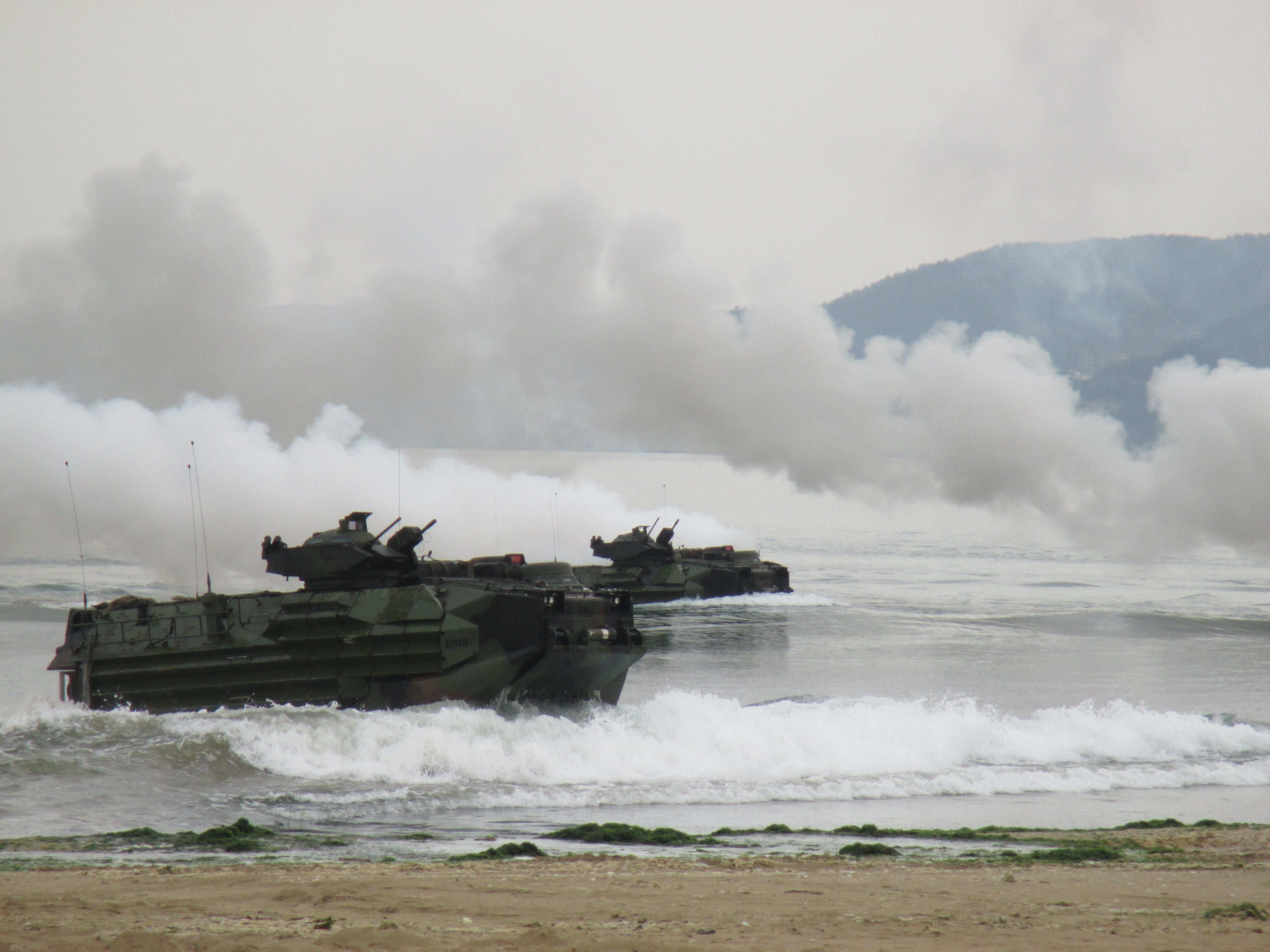
Marines aboard amphibious assault vehicles rehearse a combined forcible entry landing operation on Dogue beach in Pohang, Republic of Korea, as part of exercise Ssang Yong 2014.
Photo Credit: Capt. Caleb Eames/Marine Corps





